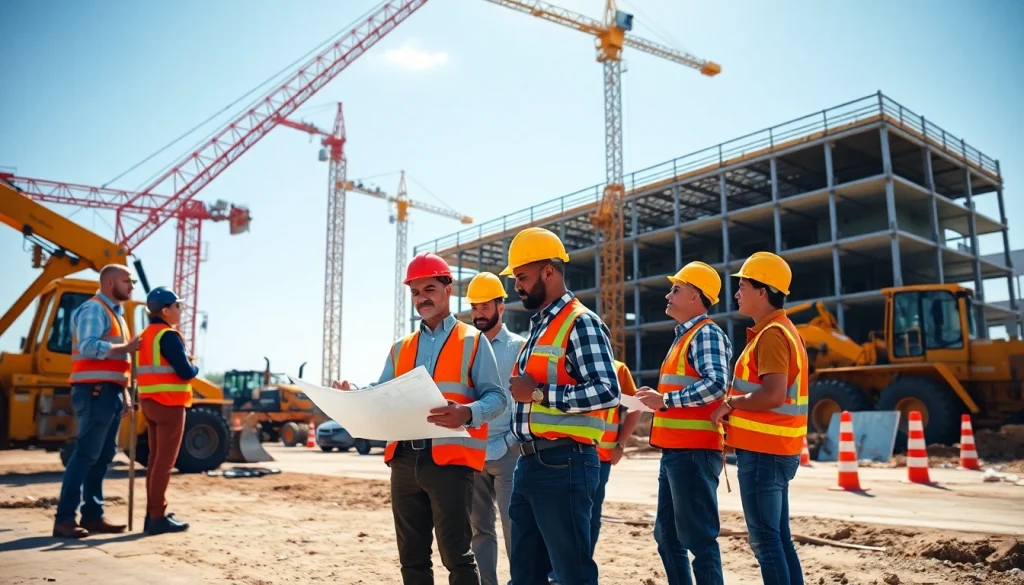Understanding the Austin Construction Market
The Austin construction industry is experiencing a surge that reflects the region’s growing economy and demographic shifts. With a blend of urban development, residential construction, and infrastructure projects, Austin has become a focal point for various construction activities. As the demand for housing and commercial space continues to rise, understanding the dynamics of this market is crucial for stakeholders involved in austin construction.
Current Trends in Austin Construction
The construction landscape in Austin is marked by several key trends. First, there has been a significant shift toward sustainable building practices, with an emphasis on utilizing eco-friendly materials and energy-efficient design. This shift is driven by both consumer preferences and regulatory requirements aimed at reducing environmental impact.
Additionally, the incorporation of smart technology in construction practices is on the rise. Building Information Modeling (BIM), for instance, allows for better visualization and planning, leading to more efficient project execution. Furthermore, an increasing number of residential and commercial buildings in Austin are now being designed with smart technology integration, enhancing energy management and user comfort.
Key Drivers of Growth
Several factors are contributing to the rapid growth of the construction sector in Austin. The city’s robust economy, fueled by a diverse job market and influx of companies, has resulted in a population boom. This surge in population increases the demand for housing and infrastructure, thus driving construction activity.
Moreover, government investments in infrastructure projects—such as transportation upgrades and public services—are essential for addressing the needs of the growing population. Additionally, the tech industry’s expansion in the area attracts both businesses and residents, further stimulating demand for commercial and residential construction.
Challenges Facing the Industry
Despite the positive outlook, the Austin construction industry faces significant challenges. A shortage of skilled labor has been a persistent issue, causing project delays and increased costs. The competition for skilled workers is intense, prompting companies to invest in training and development programs to build talent internally.
Additionally, rising material costs and supply chain disruptions pose significant hurdles. The global supply chain challenges, exacerbated by recent economic conditions, have resulted in delays and increased prices for essential construction materials. Navigating these challenges requires effective risk management strategies and proactive planning.
Best Practices for Project Management in Austin Construction
Effective Planning and Scheduling Techniques
Effective project management begins with comprehensive planning and scheduling. Establishing clear project goals and timelines is crucial for successful project execution. Utilizing software tools for scheduling can enhance visibility and collaboration among team members, ensuring that everyone is aligned on project timelines.
Break down the project into manageable phases and assign specific responsibilities to team members. Regular progress meetings can help identify potential issues early on, allowing for timely interventions to keep the project on track.
Utilizing Technology in Construction Management
Embracing technology is vital for improving efficiency and productivity in construction management. Implementing cloud-based project management tools can streamline communication and document management, making it easier to share project updates with all stakeholders.
Moreover, drones and 3D printing are being explored for construction applications in Austin. Drones can be used for site surveys and progress tracking, while 3D printing technology holds promise for more efficient building methods. Evaluating and adopting these technologies can lead to significant improvements in construction processes.
Safety Protocols and Compliance
Safety is paramount in the construction industry. Adherence to OSHA guidelines and local safety regulations is essential for protecting workers and minimizing accidents on-site. Implementing a robust safety training program, conducting regular safety audits, and fostering a safety-first culture can significantly reduce incidents.
Moreover, maintaining compliance with environmental regulations is equally important. This includes proper waste management practices and following protocols for job site cleanliness to minimize environmental impact. Ensuring safety and compliance can enhance the overall reputation of construction companies.
Key Stakeholders in Austin Construction Projects
Role of General Contractors
General contractors play a pivotal role in the construction process, acting as the primary point of contact for clients. They are responsible for overseeing the entire project, from pre-construction planning to the final walkthrough. A successful general contractor must possess project management skills and the ability to coordinate various subcontractors and suppliers.
Effective communication with clients is essential to manage expectations and ensure that the project aligns with their vision. General contractors must also be adept at handling changes efficiently and maintaining project schedules to avoid unnecessary delays.
Importance of Subcontractors
Subcontractors are crucial to the success of construction projects, providing specialized skills and expertise. Engaging reliable subcontractors can enhance project quality and efficiency. Establishing clear communication channels and expectations is vital for fostering a collaborative environment among all parties.
Moreover, contractors should ensure that subcontractors follow safety protocols and comply with regulations to mitigate risks effectively. Building strong relationships with subcontractors can lead to long-term partnerships and improved project outcomes.
Engaging with Local Government Entities
Understanding and navigating local government regulations is essential for successful construction projects. Engaging with city planners and permitting offices early in the process can expedite approvals and provide clarity on zoning laws and building codes.
Moreover, establishing positive relationships with local governments can facilitate smoother communication and encourage collaboration on community development initiatives. Keeping abreast of regulatory changes and policies will help construction professionals remain compliant and adapt their practices accordingly.
Financing Options for Austin Construction Projects
Understanding Funding Sources
Financing is a critical component of any construction project. Understanding the various funding sources available can aid in securing necessary capital. Traditional bank loans, private equity financing, and public funding options are common methods of raising funds for construction projects.
It is vital to assess the financial needs of the project accurately and choose the right type of financing that aligns with its goals. Additionally, establishing a transparent budget that factors in potential contingencies will help in managing financial risks effectively.
Evaluating Financial Risks
Every construction project carries inherent financial risks, such as cost overruns, delays, and economic fluctuations. Conducting a thorough risk assessment during the planning phase is essential for identifying potential challenges. Developing a risk management strategy that includes insurance coverage and contingency funds will help protect against unforeseen circumstances.
Regularly monitoring project finances and performance metrics can provide valuable insights into the project’s financial health, enabling proactive adjustments when necessary. Engaging financial advisors can also offer expert guidance on managing risk effectively.
Grants and Incentives for Construction
Various grants and incentives may be available to support construction projects, especially those focusing on sustainability and community development. Researching federal, state, and local programs can uncover potential funding opportunities that align with project objectives.
Leveraging these grants can not only alleviate financial burdens but also enhance project viability and community impact. Maintaining awareness of application deadlines and eligibility requirements is essential for maximizing these opportunities.
Future Projections for Austin Construction
Predicted Trends and Innovations
The future of the Austin construction market appears bright, with several trends and innovations on the horizon. The push toward sustainability in construction is expected to intensify, with an increasing number of projects adopting green building standards and sustainable practices.
Moreover, advancements in technology will continue to reshape the industry, with innovations such as autonomous construction machinery and artificial intelligence enhancing efficiency. Staying ahead of these trends will be crucial for construction professionals looking to remain competitive in the ever-evolving market.
Impact of Economic Factors
Economic conditions will always play a pivotal role in construction activity. Factors such as interest rates, unemployment rates, and consumer confidence directly affect housing demand and investment in commercial projects. Monitoring these economic indicators will provide insights into future construction trends and enable stakeholders to make informed decisions.
Moreover, fluctuating material costs and labor availability will influence project budgets and timelines. Therefore, construction professionals must remain agile and adaptable to navigate these changing economic landscapes.
Long-term Sustainability Practices
As the construction industry moves toward greater sustainability, long-term practices will be vital in driving success. Emphasizing energy efficiency, resource conservation, and waste reduction can enhance a project’s overall sustainability profile.
Implementing practices such as using recycled materials, optimizing energy systems, and engaging in sustainable site development will position construction firms favorably. Continuous education on sustainability practices and technologies will further bolster the industry’s efforts toward responsible construction.





